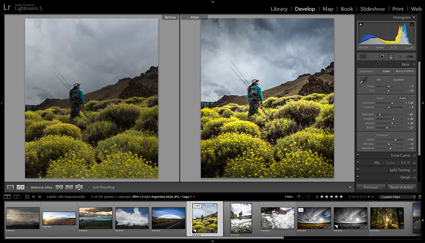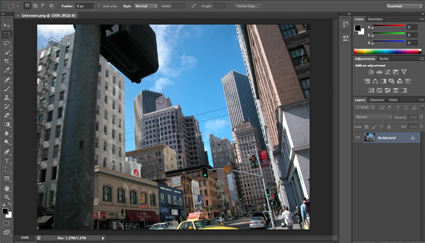The Decisive Moment – Henri Cartier-Bresson
Cartier-Bresson offers marvelous observations on the art of photography.
View more photographer’s videos here.
Read conversations with photographers here.
Cartier-Bresson offers marvelous observations on the art of photography.
View more photographer’s videos here.
Read conversations with photographers here.
Russell Preston Brown demos the latest Photoshop CC updates.
Smooth out Liquify corrections.
Easily make selections of targeted regions.
Get Photoshop CC & Lightroom 5 for $9.99 a month.
Offer good through Dec 2, 2013.
View more Photoshop Videos here.
Learn more in my digital photography and digital printing workshops.
Get 12% off NEC monitors with this discount code JPCPHOTO.
10-bit GB-R LED backlit AH-IPS LCD
Internal 14-bit programmable 3D LUTs
Wide Gamut – 99.3% of AdobeRGB
High resolution
Easy on the eye flicker rate
Now with lower power consumption and heat output
Check out NEC’s Spectraview pro monitors here.
Investing in a high quality monitor is one of the most important things we can do to ensure our digital files and prints achieve the highest quality. Visual artists who don’t invest in a great monitor are like audiophiles who don’t invest in good speakers. The monitor is what we look at; the speaker are what they listen to.
NEC’s Spectraview monitors are among the monitors that achieve the widest gamuts available today, making it possible to see more of the color contained in your digital files and more accurately represent the saturated colors that are printable with today’s fast-evolving digital printing media.
Simulating print brightness and contrast with monitors has always been one of the most challenging tasks. NEC’s unique combination of hardware and software solutions are the most sophisticated solutions available for setting monitor white, far exceeding the accuracy of the vast majority of other LCD monitor’s too bright results. As a result, predictions of print quality are significantly more accurate, saving time and media. Use NEC’s Spectraview / MultiProfiler software for best results. It calibrates the monitor’s LUTs and loads ICC profiles directly into the monitor for optimal color space matching.
Read what other top pros are saying about NEC monitors here.
Learn more about the tools I use here.
See them in action in my digital photography and digital printing workshops.
Witness – An Introduction to iLCP from iLCP on Vimeo.
“iLCP is a 501(c)3 charitable organization whose mission is to further environmental and cultural conservation through communication initiatives that create vital content and disseminate conservation messages to a wide variety of audiences.”
Find out more about ILCP here.
Find more recommended Environmental Organizations here.
Chris Orwig delivers an inspring Google Talk about how photography fuels innovation.
Read/view more about Chris on this blog, including his TED talks here.
View more Creativity Videos here.
It’s not the most dramatic wave; it’s rather small in comparison to the enormous waves you find in the Pacific ocean. The ocean waters aren’t glassy smooth; the wave line isn’t fully continuous; the surrounding waves aren’t perfectly scalloped; and the foam in the foreground serves only as accents, indicating a previous passage, rather than forming a clear and present pattern. It’s not illuminated by the clearest light nor does it glow from within. Still, there’s an intensely quiet presence about this image (Condensation X), deceptively calm on the surface but potentially turbulent below, with an air of mystery (Where is it coming from and going to? What surrounds it?) that makes it powerfully expressive in a complex and unique way. It’s not obvious but it is rewarding. You might say it’s a sleeper, something you might not pay close attention to at first but the more you look at it the more it grows on you.
Being sensitive to times when less is more and more is less will help you get it just right. In today’s constantly competitive culture, it’s hard not to over achieve. But sometimes, that’s exactly what you need to do. Sometimes what you really need is to get it just right – and nothing more.
I like to do my very best. I like to try to do it better every time. Sometimes I try too hard and do too much. I’ve wasted hours, days even, trying to perfect something only to find out that along the way the life had gone out of it. I’ve found that things that I thought were distractions were really things that made something richer and more complex, after removing them. I’ve come to the realization that what I thought were flaws made something perfectly imperfect. This is not to say that I don’t still try to make things as good as I can and even to up my game. It is to say that the answers I’m looking for transcend technical perfection and sometimes are better for less of it.
In the world of photography it’s easy to lose sight of the big picture for all of the details. We have an extensive list of physical characteristics to evaluate the quality of photographs – focus, depth of field, frozen motion (or extreme motion blur, but nothing in between), low noise, detail in highlights and shadows, contrast, credible color casts, believable levels of saturation, no lens artifacts, the list goes on – yet we are much more challenged to describe the quality of photographs on the levels of perception and content, which are more important. There are times when technical perfection can be distracting or worse a cover up for what’s lacking. Photographer Ansel Adams remarked that, “There’s nothing worse than a sharp image of a fuzzy concept.”
It’s a matter of appropriate means. You don’t want to create dynamic images to portray quiet, tender moments. You don’t want to retouch portraits of victims of war, famine, or pestilence. You don’t want to reenact the truth to make it picture perfect.
There are many times when things seem more authentic if they’re not perfect.
Besides, the more perfect your presentation becomes the more attention you call to the delivery. When you want to call more attention to the content perfect presentation may not be perfect for the purpose. Make your delivery effective. Sometimes it’s more effective to deliver just enough, not more, not less. It’s part of getting it just right.
Questions
What isn’t good enough? How do you know?
What is good enough? How do you know?
What is too much?
What is perfectly imperfect?
Find out more about this image here.
View more related images here.
Read more The Stories Behind The Photographs here.


The Photoshop Photography Program is available to anyone (long term and new customers alike) for a limited time only – Offer Expires Dec 2.
It includes all of the following for $9.99/month with a 12-month commitment.
– Photoshop CC
– Lightroom 5
– 20GB of online storage
– Behance ProSite
– Access to training resources on Creative Cloud Learn
– Ongoing updates and upgrades
(Though not legally stated, it’s Adobe’s intention to keep these same rates for everyone in this program indefinitely.)
Questions? See Adobe’s FAQ and terms.
Julianne Kost shows how to create lightweight, efficient Smart Previews to work with offline images in Lightroom.
View more Lightroom videos here.
Learn more in my digital photography and digital printing workshops.

Here’s a selection of my favorite quotes on optimism and pessimism.
“A pessimist sees the difficulty in every opportunity; an optimist sees the opportunity in every difficulty.” – Winston Churchill
“A pessimist is one who makes difficulties of his opportunities and an optimist is one who makes opportunities of his difficulties.” – Harry S. Truman
“We can complain because rose bushes have thorns, or rejoice because thorn bushes have roses.” ― Abraham Lincoln
“The optimist sees the donut, the pessimist sees the hole.” ― Oscar Wilde
“Some people see the glass half full. Others see it half empty. I see a glass that’s twice as big as it needs to be.” ― George Carlin
“The man who is a pessimist before 48 knows too much; if he is an optimist after it, he knows too little.” – Mark Twain
“The optimist proclaims that we live in the best of all possible worlds, and the pessimist fears this is true.” – James Branch Cabell
“A pessimist is a man who thinks all women are bad. An optimist is one who hopes they are.” – Chauncey Depew
“Both optimists and pessimists contribute to the society. The optimist invents the aeroplane; the pessimist, the parachute.” — George Bernard Shaw
“An optimist will tell you the glass is half-full; the pessimist, half-empty; and the engineer will tell you the glass is twice the size it needs to be.” – Anonymous
“An optimist is a person who sees a green light everywhere, while a pessimist sees only the red stoplight … the truly wise person is colorblind.” – Albert Schweitzer
“The pessimist complains about the wind; the optimist expects it to change; the realist adjusts the sails.” – William Arthur Ward
“A pessimist only sees the dark side of the clouds, and mopes; a philosopher sees both sides and shrugs; an optimist doesn’t see the clouds at all – he’s walking on them.” – Leonard L Levinson
“The nice part about being a pessimist is that you are constantly being either proven right or pleasantly surprised.” – George Will
“Go into situations expecting nothing and you always come out getting something better than you had ever expected.” – Unknown
“It doesn’t hurt to be optimistic. You can always cry later.” – Lucimar Santos de Lima
“Don’t ever become a pessimist… a pessimist is correct oftener than an optimist, but an optimist has more fun, and neither can stop the march of events.” – Robert A. Heinlein
“Many an optimist has become rich by buying out a pessimist.” – Robert G. Allen
“No pessimist ever discovered the secrets of the stars, or sailed to uncharted land, or opened a new doorway for the human spirit.” – H.Keller
“I’ve never seen a monument erected to a pessimist.” – Paul Harvey
Find more creativity quotes here.
Read more quotes daily on Twitter and Facebook.
This documentary illuminates the history of master photographer Paul Strand.
View more Videos On Photographers here.
Read conversations with photographers here.

